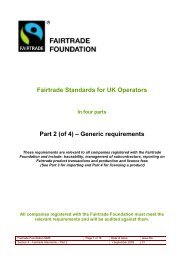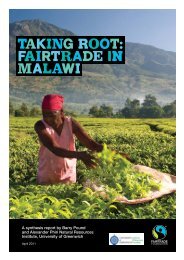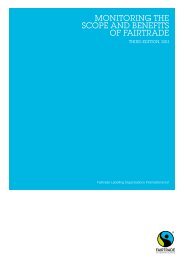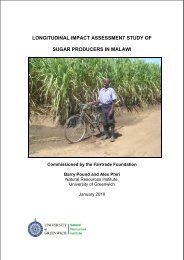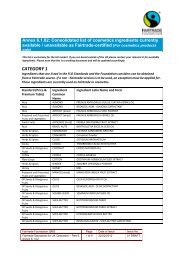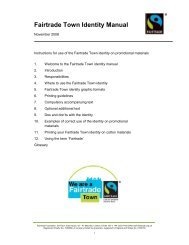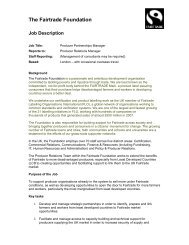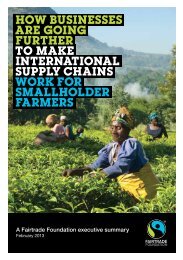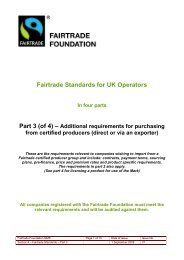the great cotton stitch-Up - The Fairtrade Foundation
the great cotton stitch-Up - The Fairtrade Foundation
the great cotton stitch-Up - The Fairtrade Foundation
Create successful ePaper yourself
Turn your PDF publications into a flip-book with our unique Google optimized e-Paper software.
<strong>The</strong> world in which West African<br />
<strong>cotton</strong> operates today<br />
World <strong>cotton</strong> production more than doubled from just<br />
under 10 million tonnes in 1960 to almost 25 million<br />
tonnes in 2010. This, despite <strong>the</strong> introduction of new<br />
and cheaper syn<strong>the</strong>tic fibres such as polyester that<br />
compete with <strong>cotton</strong> on price.<br />
Globally, much of <strong>the</strong> growth of <strong>cotton</strong> production is<br />
due to improvements in yields ra<strong>the</strong>r than areas under<br />
cultivation. Since 1945, yield levels have increased<br />
fourfold whereas <strong>the</strong> area under cultivation has only<br />
increased by a third. 3 West Africa today produces about<br />
4% of global production. <strong>The</strong> West African C-4 nations<br />
export virtually all of <strong>the</strong>ir <strong>cotton</strong>, mostly to China.<br />
China is <strong>the</strong> world’s biggest <strong>cotton</strong> producer<br />
producing 32.5% of global supply. But China<br />
consumes most of what it produces to supply its<br />
rapidly growing garment sector, and has become a<br />
net importer of <strong>cotton</strong>.<br />
In 2010 India banned exports of its <strong>cotton</strong> to meet <strong>the</strong><br />
demands of its own processors. <strong>The</strong> United States is<br />
by some way <strong>the</strong> world’s biggest exporter of <strong>cotton</strong>.<br />
In <strong>the</strong> most recent figures, it accounts for 34% of<br />
global exports. This is projected to rise.<br />
India 18%<br />
United States 34%<br />
Major producers and consumers of <strong>cotton</strong> 2009<br />
(million Major of producers metric tonnes) and consumers of <strong>cotton</strong> 2009<br />
China<br />
India<br />
United States<br />
Pakistan<br />
Brazil<br />
Uzbekistan<br />
Australia<br />
Turkey<br />
African Franc Zone<br />
Turkmenistan<br />
Rest of <strong>the</strong> world<br />
Share of world <strong>cotton</strong> exports 2009<br />
Source: US Department of Agriculture<br />
Production<br />
Consumption<br />
Rest of <strong>the</strong><br />
world 12%<br />
Uzbekistan 10%<br />
Australia 6%<br />
Brazil 6%<br />
African Franc Zone 5%<br />
Turkmenistan 3%<br />
Greece 3%<br />
Pakistan 3%<br />
Tajikistan 1%<br />
Zimbabwe 1%<br />
0<br />
Source: US Department Department of of Agriculture Agriculture<br />
5 10<br />
millions of tonnes<br />
15 20<br />
West Africa’s<br />
dependence on <strong>cotton</strong><br />
Many least developed countries are dependent on<br />
<strong>cotton</strong> for rural livelihoods and export revenue. But<br />
few places rely on it to <strong>the</strong> extent of Mali, Benin,<br />
Burkina Faso and Chad where it accounts for<br />
5%-10% of GDP. 4 All four countries are classified<br />
as ‘low human development’ in <strong>the</strong> UN’s Human<br />
Development Index. 5<br />
Unlike o<strong>the</strong>r nations, most <strong>cotton</strong> cultivation in West<br />
Africa is rain-fed, so reducing its water footprint. In<br />
fact, only a quarter of global <strong>cotton</strong> is produced in<br />
rain-fed conditions ra<strong>the</strong>r than irrigated fields.<br />
<strong>The</strong> West African C-4<br />
MAlI<br />
About 40%<br />
of rural households,<br />
or 2.5 million people,<br />
depend on <strong>cotton</strong> for<br />
<strong>the</strong>ir livelihood. Cotton is<br />
grown on around onethird<br />
of cultivated land,<br />
and provides <strong>the</strong> second<br />
largest source of<br />
foreign exchange<br />
earnings.<br />
BuRkInA FASo<br />
Cotton accounts<br />
for around 60% of<br />
export earnings<br />
and is produced<br />
by 250,000 <strong>cotton</strong><br />
growers, supporting<br />
<strong>the</strong> livelihoods of<br />
two million<br />
people.<br />
BEnIn<br />
Cotton<br />
accounts for<br />
60% of foreign<br />
exchange earnings<br />
and employs<br />
45% of rural<br />
households.<br />
Source: UNCTAD INFO COMM<br />
CHAD<br />
40% of <strong>the</strong><br />
population<br />
(around two million<br />
people) depend on<br />
<strong>cotton</strong>, which also<br />
accounts for<br />
two-thirds of<br />
exports.<br />
10 <strong>The</strong> <strong>great</strong> <strong>cotton</strong> <strong>stitch</strong>-up <strong>The</strong> <strong>great</strong> <strong>cotton</strong> <strong>stitch</strong>-up 11



